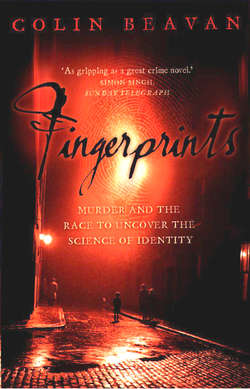| 400 A.D. | Anglo-Saxons conjure “evidence” of criminal guilt during supernatural ordeals. |
| 1215 A.D. | Pope Innocent III forbids clergy from taking part in ordeals. System of investigating juries begins in England. |
| 1504 A.D. | Henry VII ratifies first law calling for eyewitness testimony. The word “evidence” is introduced into English law. |
| 1764 A.D. | In Italy, Cesare Beccaria publishes Dei deletti e delle pene (Crimes and Punishment), heralding the rationalization of law and the burgeoning of prisons. |
| 1812 A.D. | In France, François-Eugène Vidocq establishes Europe’s first official detective branch and pioneers the use of physical evidence. |
| 1816 A.D. | Britain opens first national penitentiary at Millbank. |
| 1842 A.D. | Vidocq-style detective force established in Britain. |
| 1858 A.D. | William Herschel begins privately experimenting with fingerprints in India. |
| 1863 A.D. | Garroting epidemic scares public that hordes of criminals, once dispatched by the hangman or deportation, now roam the streets of London. |
| 1869 A.D. | Habitual Criminals Act in England provides longer sentences for hardened criminals with previous convictions. Need to identify prior offenders first arises in Britain. |
| 1870 A.D. | “The Claimant” sues for the title of Baronet of Tichborne, falsely identifying himself as the true heir, who was lost at sea fifteen years earlier. This case eventually sparks fingerprint concept in Dr. Henry Faulds’s mind. |
| 1877 A.D. | Herschel, still in India, begins year-long use of fingerprints as signatures on land titles and jailers’ warrants. |
| 1878 A.D. | Faulds, a Scottish missionary working in Japan, discovers fingerprints on ancient pottery and begins extensive experiments. |
| 1880 A.D. | Faulds becomes first person to publicly suggest fingerprints as a method of criminal identification in a letter published in Nature. |
| 1883 A.D. | Alphonse Bertillon, in Paris, identifies his first habitual criminal using his newly installed anthropometric system of measurements. |
| 1886 A.D. | Henry Faulds begins trying to convince Scotland Yard to adopt fingerprints. |
| 1888 A.D. | Francis Galton begins experimenting with fingerprints as a means of determining physical and intellectual prowess. |
| 1892 A.D. | In Argentina, fingerprint evidence leverages a confession from a mother who murdered her two children, though news of the case does not reach Europe for many years. |
| 1893 A.D. | Edward Henry, chief of police in Bengal, India, adds thumbprints to the anthropometric records he began taking the previous year. |
| 1894 A.D. | Britain adopts an identification system which is a hybrid of anthropometry and fingerprints. |
| 1896 A.D. | Adolf Beck, an innocent man, is jailed for five years after being wrongly recognized as a known con artist by police and a witness. Fingerprints would have shown he was the wrong man. |
| 1897 A.D. | Henry’s assistant Azizul Haque comes up with a comprehensive system for classifying fingerprints, making practical their use without measurements. |
| 1901 A.D. | Britain adopts the fingerprint classification system developed largely by Haque, but which has come to be known as the “Henry classification system.” |
| 1902 A.D. | Harry Jackson found guilty of burglary on evidence of fingerprints. First time fingerprints used to prove guilt in a British courtroom. |
| 1904 A.D. | United States Bureau of Identification establishes fingerprint collection. |
| 1905 A.D. | The Stratton brothers are tried and hanged on fingerprint evidence for the vicious murder of Thomas and Ann Farrow. Henry Faulds takes their side against police. |
| 1911 A.D. | Thomas Jennings is the first to be convicted of murder in the United States on the basis of fingerprint evidence. |
| 1911 A.D. | Galton dies. |
| 1913 A.D. | Bertillon dies. |
| 1918 A.D. | Herschel dies. |
| 1930 A.D. | Faulds dies. |
| 1938 A.D. | Scottish judge George Wilton begins campaign for Faulds’s recognition as a fingerprint pioneer. |
| 1987 A.D. | American fingerprint experts restore Faulds’s grave. |
| 1999 A.D. | Federal Bureau of Investigation installs massive fingerprint computer capable of storing the fingerprints of 65 million individuals. |
